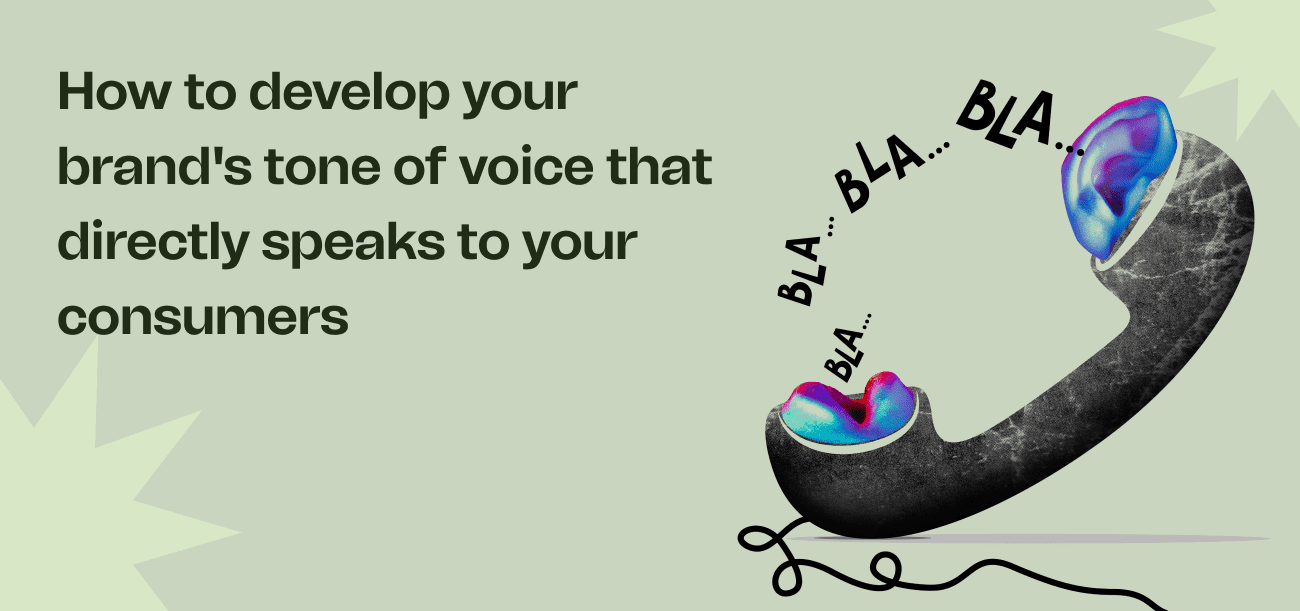Brand persona. Brand tone. Brand’s tone of voice.
Did you ask yourself if you’re creating a brand or a human?
Well, it won’t be wrong to say that a brand is more like a human. It has a personality, a tone and an image it has to keep up with.
And thinking of a brand as a human is more likely going to make sense to you because otherwise, you will just be confused about how a brand will ever have a voice.
Think of your brand as a human; you get to mould. At this very moment, you have the power to decide how this human looks, speaks, what personality it holds and what all values it looks upto.
Sounds interesting, right?
Now that that’s done let’s go ahead and discuss what your brand’s tone of voice is in the first place.
What is the brand’s tone of voice?
Let’s extend upon the hypothetical human we were making.
Imagine this person that you are moulding has a personality by now. You’ve created a physical persona for it, and now the next step is to help it communicate.
How your human will choose to communicate to its audience now will define its tone of voice.
The words and phrases it will choose, including the order in which this human will choose to frame them, will add to your brand’s tone of voice.
Imagine person A who is very friendly, talkative and informal. What words do you think will come out of this person’s mouth?
This person would probably use second-person pronouns and simple phrases and have a very natural and humble tone.
On the other hand, imagine person B. This person is very formal, likes to get into official conversations and informs people of the same. Now, what difference do you think will be there in the tone of this person from person A?
We think person B will use a more informative tone, formal words, and third-person pronouns.
This is precisely what we mean when we talk about having a brand’s tone of voice.
The person you have created, this brand that you’ve given a personality to, will be responsible for talking and conveying its message to its audience. Similar to how we analysed the tone of the above two personalities, you will define the tone of voice for your brand.
However, no book says your tone of voice can’t change. It can and will have to eventually when your communication medium will change. For instance, any brand will have to get a little formal on PRs, but that does not mean they’ve changed their tone of voice completely.
The tone stays consistent unless there is a considerable change in the audience or the media you use.
But why do you need a brand’s tone of voice after all?
A brand without a defined tone communicates too. But effective communication comes from a defined brand tone of voice. The impact of your brand message is different when you stay consistent with your personality throughout every touchpoint of your customer’s journey. But what else can your brand’s tone of voice do for you?
1. Connects you directly with your audience
People usually connect with the brands more that they find relatable. This relatability is built through different things like the content you make available to them and the tone of voice in which you communicate. Customers need to sense a caring vibe from the brands they choose to connect with, and the same is done via different strategies of branding, one of which is the brand’s tone of voice.
2. It helps you gain your audience’s trust.
Building trust with your target audience is not something that gets done by deploying a single strategy. From creating consistent value-packed content throughout customer touchpoints to engaging in moral business conduct and prioritising their needs and wants – every bit of it matters. Consistency in the brand’s tone of voice helps them understand you as a business and believe in your authenticity.
3. Increased Revenue
A study of brand consistency conducted by Lucidpress has revealed that brand’s that focus on the consistency of their tone of voice experience a boost in sales of 23% compared to those who do not prioritise the same. Thus, deploying a strategy that lets you communicate consistently with your audience through different channels is an effort that can reap better results than expected.
Here’s how you can define your brand’s tone of voice step-by-step
- Get to know your audience.
First thing first, and this should go without saying, a strategy is deficient if relevant research inputs do not back it. Thus, instead of jumping straight to the stage of framing a brand’s tone – start from scratch by understanding your audience from a different perspective – as you’ve never done before.
This effort will help you gather relevant information and data about the audience you are targeting that you can use in the latter stages. There are literally a zillion ways to do the same, but you can take the first step by analysing Google Metrics and Social Media Analytics.
The next thing you need to do is ask yourself: How would you address these people now that you know them in and out?
Will this audience appreciate a formal tone, or will they be more comfortable with informal communication?
These user personas will help you identify the same when you will think of them as real people you want to do small talk with.
- Consider the medium of communication.
Figuring out your brand tone of voice becomes difficult if you are unaware of the platforms where your audience can be found.
You can also consider the age of your audience to figure this out. As we can see, those born in their 20s are more inclined toward social media platforms like Instagram and Youtube. At the same time, those belonging to older generations may be found hanging out on Facebook more.
Once you know these little details, you can research what your competitors are doing on these platforms to attract their audience, where they are lagging and how you can deploy a more workable and efficient strategy to stand out.
- Jot down your brand’s values
Remember, your brand’s tone of voice isn’t entirely about what your audience needs to hear. It’s also about what you need to convey and how you choose to do it. You must be clear of your ultimate objectives and the principles your business follows and believes in.
Once you answer these two questions about your business, you should be able to form a more cohesive brand tone that conveys your message clearly and reaches the audience it’s meant to.
- Establish a messaging framework
The primary role of a brand messaging architecture is to align your brand’s communication through different channels with your brand’s set values and beliefs. These are communication goals laid down with the help of phrases and statements like “friendly” or “formal”.
The ultimate objective of creating a messaging framework is to embed consistency in messages shared through different platforms via different people of a business.
Every time you try to keep your brand’s tone of voice consistent, it becomes more noticeable for your audience, provided clear guidelines are laid down and followed. Without a tone of voice, communication might not leave anything behind for the engaged customers, and they might remain in anticipation as to what yur brand aims to offer.
All you need is a clear message and then decide on using the right words, phrases and language to convey the same in a way it reaches the audience and leaves the desired impact.







